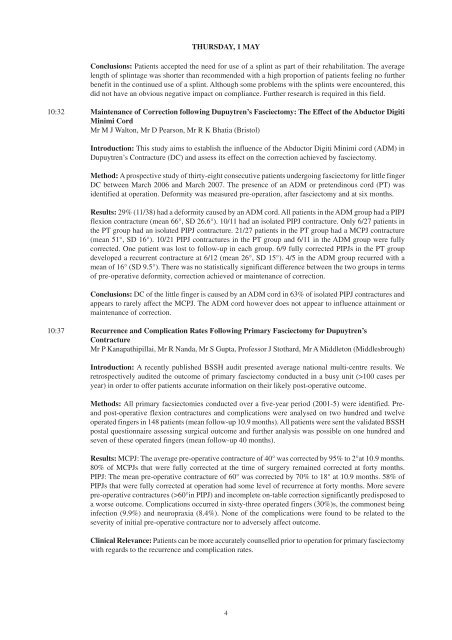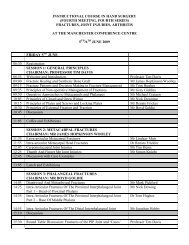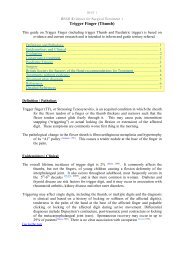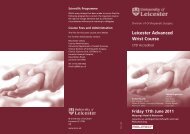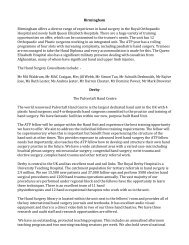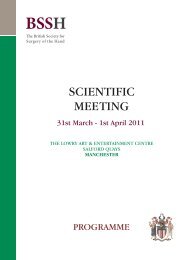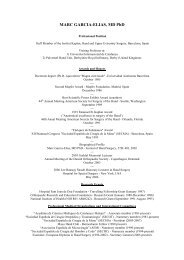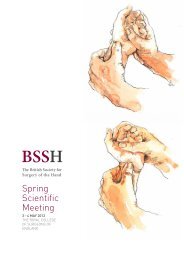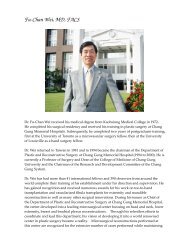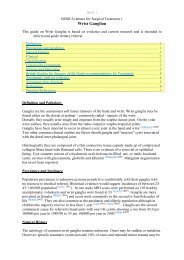here - The British Society for Surgery of the Hand
here - The British Society for Surgery of the Hand
here - The British Society for Surgery of the Hand
You also want an ePaper? Increase the reach of your titles
YUMPU automatically turns print PDFs into web optimized ePapers that Google loves.
THURSDAY, 1 MAY<br />
Conclusions: Patients accepted <strong>the</strong> need <strong>for</strong> use <strong>of</strong> a splint as part <strong>of</strong> <strong>the</strong>ir rehabilitation. <strong>The</strong> average<br />
length <strong>of</strong> splintage was shorter than recommended with a high proportion <strong>of</strong> patients feeling no fur<strong>the</strong>r<br />
benefit in <strong>the</strong> continued use <strong>of</strong> a splint. Although some problems with <strong>the</strong> splints were encountered, this<br />
did not have an obvious negative impact on compliance. Fur<strong>the</strong>r research is required in this field.<br />
10:32 Maintenance <strong>of</strong> Correction following Dupuytren’s Fasciectomy: <strong>The</strong> Effect <strong>of</strong> <strong>the</strong> Abductor Digiti<br />
Minimi Cord<br />
Mr M J Walton, Mr D Pearson, Mr R K Bhatia (Bristol)<br />
Introduction: This study aims to establish <strong>the</strong> influence <strong>of</strong> <strong>the</strong> Abductor Digiti Minimi cord (ADM) in<br />
Dupuytren’s Contracture (DC) and assess its effect on <strong>the</strong> correction achieved by fasciectomy.<br />
Method: A prospective study <strong>of</strong> thirty-eight consecutive patients undergoing fasciectomy <strong>for</strong> little finger<br />
DC between March 2006 and March 2007. <strong>The</strong> presence <strong>of</strong> an ADM or pretendinous cord (PT) was<br />
identified at operation. De<strong>for</strong>mity was measured pre-operation, after fasciectomy and at six months.<br />
Results: 29% (11/38) had a de<strong>for</strong>mity caused by an ADM cord. All patients in <strong>the</strong> ADM group had a PIPJ<br />
flexion contracture (mean 66°, SD 26.6°). 10/11 had an isolated PIPJ contracture. Only 6/27 patients in<br />
<strong>the</strong> PT group had an isolated PIPJ contracture. 21/27 patients in <strong>the</strong> PT group had a MCPJ contracture<br />
(mean 51°, SD 16°). 10/21 PIPJ contractures in <strong>the</strong> PT group and 6/11 in <strong>the</strong> ADM group were fully<br />
corrected. One patient was lost to follow-up in each group. 6/9 fully corrected PIPJs in <strong>the</strong> PT group<br />
developed a recurrent contracture at 6/12 (mean 26°, SD 15°). 4/5 in <strong>the</strong> ADM group recurred with a<br />
mean <strong>of</strong> 16° (SD 9.5°). T<strong>here</strong> was no statistically significant difference between <strong>the</strong> two groups in terms<br />
<strong>of</strong> pre-operative de<strong>for</strong>mity, correction achieved or maintenance <strong>of</strong> correction.<br />
Conclusions: DC <strong>of</strong> <strong>the</strong> little finger is caused by an ADM cord in 63% <strong>of</strong> isolated PIPJ contractures and<br />
appears to rarely affect <strong>the</strong> MCPJ. <strong>The</strong> ADM cord however does not appear to influence attainment or<br />
maintenance <strong>of</strong> correction.<br />
10:37 Recurrence and Complication Rates Following Primary Fasciectomy <strong>for</strong> Dupuytren’s<br />
Contracture<br />
Mr P Kanapathipillai, Mr R Nanda, Mr S Gupta, Pr<strong>of</strong>essor J Stothard, Mr A Middleton (Middlesbrough)<br />
Introduction: A recently published BSSH audit presented average national multi-centre results. We<br />
retrospectively audited <strong>the</strong> outcome <strong>of</strong> primary fasciectomy conducted in a busy unit (>100 cases per<br />
year) in order to <strong>of</strong>fer patients accurate in<strong>for</strong>mation on <strong>the</strong>ir likely post-operative outcome.<br />
Methods: All primary facsiectomies conducted over a five-year period (2001-5) were identified. Preand<br />
post-operative flexion contractures and complications were analysed on two hundred and twelve<br />
operated fingers in 148 patients (mean follow-up 10.9 months). All patients were sent <strong>the</strong> validated BSSH<br />
postal questionnaire assessing surgical outcome and fur<strong>the</strong>r analysis was possible on one hundred and<br />
seven <strong>of</strong> <strong>the</strong>se operated fingers (mean follow-up 40 months).<br />
Results: MCPJ: <strong>The</strong> average pre-operative contracture <strong>of</strong> 40° was corrected by 95% to 2°at 10.9 months.<br />
80% <strong>of</strong> MCPJs that were fully corrected at <strong>the</strong> time <strong>of</strong> surgery remained corrected at <strong>for</strong>ty months.<br />
PIPJ: <strong>The</strong> mean pre-operative contracture <strong>of</strong> 60° was corrected by 70% to 18° at 10.9 months. 58% <strong>of</strong><br />
PIPJs that were fully corrected at operation had some level <strong>of</strong> recurrence at <strong>for</strong>ty months. More severe<br />
pre-operative contractures (>60°in PIPJ) and incomplete on-table correction significantly predisposed to<br />
a worse outcome. Complications occurred in sixty-three operated fingers (30%)s, <strong>the</strong> commonest being<br />
infection (9.9%) and neuropraxia (8.4%). None <strong>of</strong> <strong>the</strong> complications were found to be related to <strong>the</strong><br />
severity <strong>of</strong> initial pre-operative contracture nor to adversely affect outcome.<br />
Clinical Relevance: Patients can be more accurately counselled prior to operation <strong>for</strong> primary fasciectomy<br />
with regards to <strong>the</strong> recurrence and complication rates.<br />
4


